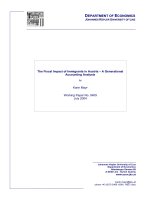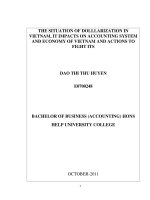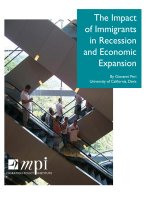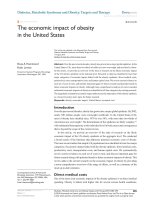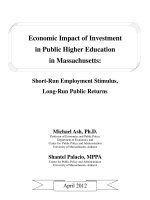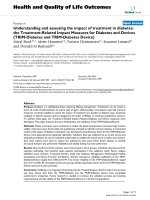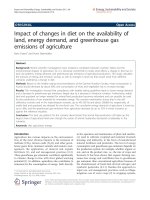The impact of the foreign ownership on the real earnings management of firms in vietnam
Bạn đang xem bản rút gọn của tài liệu. Xem và tải ngay bản đầy đủ của tài liệu tại đây (207.21 KB, 30 trang )
Tran Thi Thuy Linh et. al.
| 621
The impact of the foreign ownership on
the real earnings management of firms in
Vietnam
TRAN THI THUY LINH
University of Economics HCMC –
NGUYEN THANH NHA
HOANG THI PHUONG ANH
DANG THI VY NGOC
Abstract
The paper analysed the impacts of the foreign ownership on the
behaviour of the real earnings management of firms in Vietnam and the
difference in the quality of operating income between firms with high
and low levels of the foreign ownership. Data of 167 firms listed on the
Vietnam Stock Exchange for the duration from 2011 to 2015 was taken
as the case study and the regression models which are OLS, Robust and
2SLS were applied.
Results of this study demonstrated that the foreign ownership
contributed to the behaviour of the real earnings adjustment of firms; a
high level of the foreign ownership was found to positively affect the
real earnings management of firms in Vietnam. In addition, this study
supported the knowledge spillover theory that highly skilled foreign
investors had the tendency to assist their owned firms to improve the
earnings quality on financial reports. Therefore, it was important for
financial managers to develop appropriate strategies to manage and
improve the quality of financial reports according to the International
Financial
Reporting
Standards
(IFRS).
This
helped
increase
competitiveness and transparency of firms to attract more foreign
investors on the Vietnam Stock Exchange.
Keywords: foreign ownership; real earnings adjustment; real
earnings management; earnings quality; abnormal levels of operating
cash flows.
622 | ICUEH2017
1. Introduction
In emerging markets, foreign investors play an important role in
improving the quality of financial reports of domestic firms (Huang
and Shiu, 2009). They can promote the management of domestic
firms by using the voting right to influence decisions of managers
or to announce divestment from domestic firms (Aggarwal et al.,
2005; Gillan and Starks, 2003). According to the report of World
Bank in 2016, the foreign investment increased by 40%, which
was approximately $1.8 trillion in 2015; this was the highest since
the global financial crisis in 2008. Therefore, foreign investors and
investment greatly affect the financial management of firms.
In Vietnam, for the past 10 years, the Government has
developed and loosened regulations of attracting foreign
investment. Together with the admission of the international trade
organisation, this has contributed significantly to the integration
of Vietnam into the world market. Vietnam has removed barriers
for foreign investors and facilitate both indirect and direct capital
investment. Using 167 firms listed on Vietnam Stock Exchange as
the case study, this paper focuses on analysing impacts and
relationship between the foreign ownership and earnings quality
of these firms. The objectives of this study are to uncover: (1)
influences of the foreign investment on the earnings management
of firms and (2) impact of high and low levels of the foreign
ownership on the earnings quality of firms.
2. Background theories and empirical studies
2.1. Background theories
The study of impacts of the foreign ownership on the earnings
quality was based on the asymmetric information theory and the
knowledge spillover theory.
The asymmetric information theory was studied by George
Akerlof, Michael Spence and Joseph Stigliz (1970). Regarding to
the earnings management, the asymmetric information occurs
when managers take the advantage of the fact that foreign
investors have very little information of situation of firms and
domestic market and, therefore, make fraudulent acts, adjust
profit and indicators on financial reports. These activities lead to
the fact that investors, particular foreign investors, cannot control
behaviours of firms; they are classified as the moral hazard. In
addition, the standards and regulations
Tran Thi Thuy Linh et. al.
| 623
of accounting in a particular country may cause restrictions on the
understanding of foreign shareholders. Therefore, in a firm with a
large number of foreign shareholders, managers can manage and
adjust income for their own purposes. This is called the
asymmetric information which is less favourable by foreign
investors than domestic investors. As pointed out by Choe et al.
(2001) and Dvorak (2005), in the Indonesian market, domestic
investors have more profit compared to foreign investors. Thus,
according to the asymmetric theory, the real earnings adjustment
is more likely on firms with higher level of the foreign ownership.
The knowledge spillover theory
Alfred Marshall (1890) was the first researcher studying impacts
of the kwowledge spillover theory, which was extended by the
economist Kenneth Arrow (1962) and Paul Romer (1986). Later,
Edward Glaeser, Hedi Kallal, José Scheinkman and Vàrei Shleifer
(1992) developed a theory called MAR spillover. Accoring to
Carlino (2001), the spillover facilitates exchange of ideas and
promotion of creativity and innovation which are the important
factors for sustainable economic development of countries. Based
on this theory, the concentration of firms in a similar industry
helps spread knowledge and initiate growth and innovation.
Regarding to issues of the real earnings management, knowledge
of accounting and management is enhanced via foreign investors,
which enables firms to effectively monitor business activities and
report financial status. Therefore, the knowledge spillover theory
suggests that firms with high level of the foreign ownership tend
to perform more real earnings adjustment in a comparison with
ones having low level of the foreign ownership.
2.2. Empirical studies
Xiao et al. (2004) argued that foreign investors faced more
challenges due to the asymmetric information than the domestic
investors did and managers had more information of status of
firms and market compared to foreign investors. Therefore, real
earnings adjustment is still likely in firms having high foreign
ownership. Similarly, Klai and Omri (2001) showed that the
presence of foreign investors reduced the quality of financial
reports. Adebiyi and Olowookere (2006) argued that firms with
high level of foreign ownership are associated with high real
earning adjustment. On the contrary, other studies showed that,
with better knowledge and information, foreign investors are more
capable of spreading their expertise to domestic firms to improve
the quality and
624 | ICUEH2017
efficiency of their business productivity. According to Seaholes
(2000), foreign financial institutions perform better than domestic
ones, since the foreign ownerships creates significant economic
benefits. Based on studies in Canada, Italy, Germany, Japan, UK and
US, Hejazi and Safarian (199) pointed out that the foreign ownership
has positive spillover effects on efficiency and technology. HallwardDriemeiter et al. (2002) conducted surveys in Indonesia, South
Korea, Malaysia, Philippines and Thailand and found that foreignowned enterprises in East Asia are more productive compared to
other firms. The study of Ho et al. (2010) showed that, in small
enterprises, the more the foreign ownership, the greater the
relationship between technology investment and firm productivity;
therefore, foreign investors tend to bring IT professionals to help
small enterprises. Abor and Biekpe (2007) demonstrated that foreign
ownership has positive impact on the quality and productivity of
small and medium enterprises. According to Aydin, Sayim and
Yalama (2007), foreign-owned enterprises contribute more to
enhance the financial performance and improve the performance
compared to owned enterprises in the county. Gillan and Starks
(2003) argued that foreign investors are the key role in promoting
changes in the corporate governance of firms through direct
monitoring by using their voting rights to affect managerial decisions
or indirect monitoring by threatening to sell their shares. Aggarwal et
al. (2011) investigated impacts of financial institutions on the
corporate governance system and argued that a firm with
investment from foreign financial institutions has a stronger
foundation to promote the development of management. According
to Ben-Nasr, using data collected from firms in 45 different countries,
Boubakri and Cosset (2015) showed that the higher level the foreign
ownership the higher the quality of income. Alaryan (2015) pointed
out that the foreign ownership plays a vital role in ensuring the
quality of profit. Taking Jordan as an example, he found that the
knowledge spillover theory was supported and that the higher
foreign ownership leads to more control over the management of
domestic business income. Gue et al. (2005) studies foreign
shareholders and real earnings adjustment on financial reports and
suggested that foreign shareholders have positive effects on the
quality of the real earnings. The higher the foreign ownership, the
lower the real earnings adjustment; this is the factor to restrict real
earnings adjustment.
Tran Thi Thuy Linh et. al.
| 625
3. Research methodology
3.1. Research data
Research data was collected from the following websites:
www.hsx.vn, The main
sample of data used in this study was 167 firms listed on Ho Chi
Minh Stock Exchange (HOSE) in the duration from 2011 to 2015
and contained 835 observations in 5 main major disciplines
including Consumer Discretionary, Industrials, Real Eastate,
Materials and Consumer Staples. Firms were categorised
according to the Global Industry Classification Standards (GICS).
Table 1
Foreign ownership of different disciplines
No
Disciplines
1
Consumer Discretionary
2
Industrials
3
Real Estate
4
Materials
5
Consumer Staples
Total
FO is the percentage of shares held by foreign investors. The authors collected
the data from in the duration from 2011 to 2015.
The classification was based on GICS and firms relating to utilities and finance
were neglected.
Source: Stata analysis performed by the authors.
3.2. Research hypothesis
This study was based on the work of Guo et al. (2015) which
was focused on the Big Bang Accounting Reform in Japan.
Hypothesis 1: Firms with high levels of the foreign ownership
involve in the management of the real earnings more than the
ones with low levels of the foreign ownership, which supports the
knowledge spillover theory.
626 | ICUEH2017
Hypothesis 2: Firms with high levels of the foreign ownership
involve in the management of the real earnings less than the ones
with high levels of the foreign ownership, which supports the
asymmetric information theory.
3.3. Description of variables
3.3.1. Independent variables
The foreign ownership (FO) of the firm, which was studies in the
studies of Dahlquist et al. (2003) and Leuz et al. (2009), is the
ratio of the number of shares held by foreign investors (which
include private foreign investors, supporting funds and financial
institutions) to the total amount shares of a firm. For one firm, this
variable is the measurement of influences of foreign investors on
the domestic market at the end of each year. FO is defined as
!" = $%&'() +, -ℎ/)(- ℎ+01 '2 ,+)(345 356(-7+)- 9100
8+7/0 5%&'() +, -ℎ/)(- +, 7ℎ( ,3)&
In addition, the regression model contains other variables
showing the economic characteristics of the firm, which include:
The size (SIZE) of the firm: The size of the firm has an important
effect on the management of the real earnings (Roychowdhury
2006). SIZE is given by:
<=>? = @5(8+7/0 /--(7-)
LEVERAGE: Previous studies showed that firms use the leverage
to avoid breaking debt agreement when performing any activities
relating the real earning management (Dichev and Skinner, 2002).
This action is important since most of firms are supported by
banks and creditors can hold important roles in monitoring
business activities of firms. LEVERAGE is calculated as
@?C?DEF? = @+54 7()& 03/'3037(-
8+7/0 /--(7-
Return on assets (ROA): To control effects of financial
performances on the real earning management, the regression
model includes ROA which is a reliable index to justify financial
performances of firms and to show efficiency in deploying assets.
37(&-8+7/0 /-D"E = =5G+&( '(,+)( (97)/+)135/)2
(7-
Tran Thi Thuy Linh et.
al. | 627
Growth of assets (GROWTH): Roychowdhury (2006) showed that
potential sustainable growth of assets can lead to substantial
changes in the real earnings management.
8+7/0 /--(7- 35 2(/) 7
FD"H8I =
8+7/0 /--(7- 35 2(/) 7 − 1
−1
Absolute values of discretionary accruals (ABS_DA): Cohen et al. (2008)
showed the existence of the trade-off between the real earnings
management and the saving management. Therefore, ABS_DA
was included in their study. DA is estimated based on Kothari et
al. (2005) while ABS_DA is the remaining calculated from
MN
8EKL =
E<
Table 2
Descriptions of variables in the equation of TA
Equations
Notation
∆<ℎ+)7 7()& E--(7- − ∆ W/-ℎ + Sℎ+)7 7()& =56(-7&(57
E--(7-LOP
Variables
Total
TA
[
\]]^_]`aO[
∆SALES
− ∆<ℎ+)7 7()& 1('7 − ∆Y(Z)(G3/73+5 8+7/0
1
8+7/0 E--(7-K,LOP
Accruals
8+7/0 E--(7-LOP
8/543'0( !39(1 E--(7-
8+7/0 E--(7-LOP
=5G+&( '(,+)( (97)/+)135/)2 37()&-
8+7/0 E--(7s LOP
Total
assets
Differenc
e sales
Tangibl
e
PPE
ROA
fixed
Asse
ts
Return on
Assets
Source: Authors’ summary.
According to Chung et al. (2004), the discretionary accruals can
help managers adjust the real earnings. This variable is, therefore,
used to increase the accuracy of the regression model and to
emphasise the importance of the income management.
Dummy variable SUSPECT: The study of Roychowdhury (2006)
pointed out that firms
with 0 < ROA < 0.5% are more likely to adjust the real earnings
and are associated to suspicious cash flow, low discretionary expenses
and high production costs. Therefore,
628 | ICUEH2017
model because Roychowdhury (2006) showed that small loss and
slightly negative variation in earnings can motivate firms to adjust
their earnings to satisfy their previous profit.
3.3.2. Dependent variables
In this study, the variable of the real earnings management
were defined based on studies of Roychowdhury (2006) and
Cohen et al. (2008). These studies pointed out that the real
earnings management are defined by four indices which are
abnormal levels of operating cash flow (ACFO), abnormal
discretionary expenses (ADIS), abnormal production costs
(APROD) and a combined measure (COM_REM)
Abnormal levels of operating cash flows (ACFO): According to the study
of Roychowdhury (2006) which was based on Dechow et al.
(1998), managers can use excessive price discounts or credit
terms to boost temporary sales, which lead to the current period
earnings increase. However, current period cash flows may not go
up.
Abnormal discretionary expenses (ADIS) is a subjective cost that is not
necessary for business operation (Roychodhury 2006). This cost
was defined as the summation of advertising expenses, R&D
expenses, and selling, general and administrative expenses.
Although these expenses are not essential to business operation,
managers can use them to increase earnings by reducing current
expenditures.
Abnormal production costs are the third index used by
Roychowdhury (2006). The study of Pan (2009) showed that firms
try to increase their profit by reducing discretionary expenses and
cost of goods sold. Then, managers can increase production more
than being required to decrease average cost per unit, which
leads to lower the reported cost of goods sold (COGS) and inflate
operating profit margins. The excessive production also leads to
higher production and inventory holding costs. For a given level of
sales, this increases annual production costs and lowers current
period cash flows. The production costs were defined as the
summation of COGS and changes in inventory during the year.
Tran Thi Thuy Linh et. al.
| 629
A combined measure (COM_REM): According to Cohen et al
(2008), a combined measure was defined as aggregating three
aforementioned variables: ACFO, ADIS, and APROD. In detail, this
variable is defined as ACFO + ADIS – APROD.
Table 3
Description of four indices relating to the variable of the real
earnings management (REM)
Notation
ACFO
ADIS
APROD
COM_REM
Source: Authors’ summary.
This table listed original studies of the four indices and
estimated results in the following 3 equations by the OLS
regression model:
1
W!"L
E
= sN + sP ∗
LO P
Y=
E
= sN + sP ∗
LO P
TD"YL
E
= sN + sP ∗
LOP
The impact of foreign ownership regression for the four criteria
for the expression of real earnings management. By equation:
D?y = sN + sP ∗ !" + sS ∗ <=>? + sU ∗ @?C?DEF? + sw ∗ D"E + sz
∗ E{<_YE + s} ∗ FD"H8I + s~ ∗ @"<< + s ∗
The authors used the panel data, the Ordinary Least Square
(OLS) regression model, the descriptive statistics and the
correlation between variables to uncover statistically meaningful
variables. The authors performed Durbin-Watson test, White test
and Heteroskedasticity test: Breuch-Pagan-Godfrey to correct the
OLS regression. In addition, the authors used the robust and the
two-stage least squares (2SLS) regression.
630 | ICUEH2017
4. Research results
4.1. Descriptive statistics and correlation analysis
Table 4
Foreign ownership in different years
Year
N
2011
1
2012
1
2013
1
2014
1
2015
1
Total
Source: Authors’s compilation by stata 12.0
Table 4 presents the variation of the foreign ownership in different
years. There were 167 firms each year in the sample of data. The
averaged ownership of foreign investors in the duration from 2011 to
2015 was 13.18%. The averaged ownership was increasing and
reached 14.37& in 2015. In a comparison with Vo (2015), the
averaged foreign ownership of Vietnam increased from 10%
measured in 2007 to 51.3% measured in 2015. This result showed
that the foreign investors play a more important role in firms in
Vietnam.
Table 5 reports results of the statistics of all samples (835
observations). The mean values (MEAN) of ACFO, ADIS, APRO and
COM_REM were 0.000. These mean values are positive and much
smaller than expected value; in addition, they are very small that
was close to 0. Therefore, a good agreement can be concluded.
When using all samples, the mean and median of the foreign
ownership was estimated to be 13.25% and 7.3% respectively,
which shows that the distribution of the foreign ownership of firms
in Vietnam was unbalanced. The averaged value of ABS_DA was
0.121. The mean and median of total assets was 159 billion nad
26 billion VND. The averaged long-term liabilities was accounted
for 12.2% of the total assets. 5.87% of the total firms have
negative profit and 9.82% of the total firms were suspicious due
to very small positive profit.
8
Tran Thi Thuy Linh et. al.
| 631
Table 5
Descriptive statistics of all samples
Variable
ACFO
ADIS
APROD
COM_REM
FO
SIZE
LEVERAGE
ROA
ABS_DA
GROWTH
LOSS
SUSPECT
Source: Authors’s compilation by stata 12.0
Table 6 describes the correlation matrices of all samples. In
addition to 4 dependent variables, there was weak correlation
between variables in the regression model. The variable FO
possessed the positive correlation with ACFO, ADIS and COM_REM
and negative correlation with APROD, which supported the
knowledge spillover theory that the foreign ownership positively
affects the real earnings management. The variables SIZE and
ROA had the strongest correlation with FO, 30.5% and 15.6%
respectively. In general, there were good correlation between ROA
and other REM variables: 0.352 with ACFO, 0.184 with ADIS,
-0.415 with APROD and 0.436 with COM_REM.
632 | ICUEH2017
4.2. The correlation matrix of the variables in the model
Table 6
Correlation matrix of variables
ACFO
A
ACFO
1
ADIS
0.122
APROD
-0.547
COM_REM
0.791
FO
0.130
SIZE
-0.081
LEVERAGE
-0.031
ROA
0.352
ABS_DA
-0.157
GROWTH
-0.228
LOSS
-0.045
SUSPECT
-0.122
Source: Authors’s compilation by stata 12.0
Tran Thi Thuy Linh et. al.
| 633
Table 6 reports the correlation between variables in the
research model. In addition to the four dependent variables, the
variables in the model are almost not strongly correlated. The
variable foreign ownership- FO is positively correlated with the
variables ACFO, ADIS, COM_REM but which is negatively
correlated with the variable APROD. It is a good indicator of the
knowledge spillover theory that foreign ownership has a positive
impact on income management.
Table 7
Determine the sample mean/median difference.
Variable
ACFO
ADIS
APROD
COM_REM
SIZE
LEV
ROA
ABS_DA
GROWTH
LOSS
SUSPECT
This table examines the mean difference between low and high foreign
ownership groups. The variables are defined in section 3.3. Enterprises are
classified as high foreign ownership, if the foreign ownership is
634 | ICUEH2017
greater than and equal to 10%; and the foreign ownership is low if vice versa. *,
**, and *** denote significance level of 10%, 5% and 1% respectively
Source: Authors’s compilation by stata 12.0
Table 7 shows the results of the mean/median difference
between the two groups of high, low and comparable foreign
ownership. The author finds that the average of abnormal cash
flows from operations (ACFO), abnormal discretionary expenses
(ADIS), and the comprehensive real earnings management
measure (COM_REM) are notably higher for the high foreign
ownership firms than the for the low foreign ownerships firms,
which indicates that high foreign ownership firms less likely
involve in real earnings management. In contrast, the abnormal
production cost (APROD) is significantly lower for high foreign
ownership firms than for low foreign ownership firms, suggesting
that a greater foreign investment base will be less likely impacted
by real earnings management. High foreign ownership firms
achieve the everage of SIZE, ROA, and GROWTH higher than low
foreign ownership firms.Therefore, we can conclude that foreign
investors prefer large firms with a high of return on total assets
also a high annual asset growth.
This study also finds that the average value of the absolute
value of discretionary accruals (ABS_DA) of the low foreign
ownership firms are higher than the high foreign ownership firms.
Assume that firms with more foreign investors are less likely to
use discretionary accurals for earnings management, which is
suitable for the findings of Chung et al. (2004). In addition, the
paper mentions that foreign investors hold disproportionate
shares in firms, they will hold more shares in firms with better
accounting performances and with low leverage, which is
consistent with the evidence from Kang and Stulz (1997).
Furthermore, the results show that high foreign ownership firms
have higher growth opportunities than low foreign ownership
firms. Moreover, high foreign invested enterprises are less likely to
be classified as suspected enterprises with earnings adjustment
activities.
4.3. Results of the OLS regression model
4.3.1. Regression Results for 4 Real Earnings Management
(REM)
Table 8 presents the estimated parameters from the real
earnings management models by results of the OLS regressions.
Tran Thi Thuy Linh et. al.
| 635
Table 8
Summary of measurement of indicators showing real earnings
Equation
Intercept
1/A
t-1
S /A
t
t-1
S /A
t-1
∆
∆
S /A
t
t-1
t-1
S /A
t-1
t-1
2
R
Note: Estimated results in the following 3 equations by the OLS regression model:
!"#$
%
$&'
45/$
%
=)*+)'∗
$&'
9:#4$
%
$&'
the table shows the results of regression coefficient and the t
test value in parentheses. *, **, and *** denote significance level
of 10%, 5% and 1% respectively Source: Authors’s compilation
by stata 12.0
From the regression coefficient of equations (1, 2, 3), the author
re-estimates the dependent variable by the model, the differences
between the estimated data from the model and real collected
data are actual earnings management variables such as ACFO,
ADIS, APROD correspondingly with equations (1), (2), (3).
636 | ICUEH2017
4.3.2. Results of the regression model
Table 9
Results of the OLS regression model of foreign ownership and real
earnings quality.
Equation
_CONS
FO
SIZE
LEVERAGE
ROA
ABS_DA
GROWTH
LOSS
SUSPECT
OBS.
2
R
Note: This table summarizes the results of foreign ownership regression for the
four criteria for the expression of real earnings management. All variables are
defined in section 3.3. By equation:
:=> = )* + )' ∗ "# + ). ∗ /5?= + )0 ∗ @=A=:%B= + ); ∗ :#% + )C ∗ %D/_4% + )F ∗ B:#GHI + )J ∗ @#// + )K ∗
/L/9=!H + 2$ (4)
the table shows the results of regression coefficient and the t test value in parentheses.
*, **, and *** denote significance level of 10%, 5% and 1%
respectively Source: Authors’s compilation by stata 12.0
The research performs regression based on the OLS regression
model examines the relationship between foreign ownership and
real earnings management according to equation (4), and
according to different real earnings management solutions. Table
9 reports the results of the regression analysis. Model 4.1 (column
1), the study uses the abnormal cash flows from operations
(ACFO) as the dependent variable, the ACFO model is calculated
based on the foreign ownership function and other characteristics
of the companies. Test statistics and significance levels are based
on the standard errors,
Tran Thi Thuy Linh et.
al. | 637
adjusted by clustering at the firms and year levels. Consequently,
our standard error is conservative, since explanatory variables are
determined at the firm level (Bertrand et al., 2004). The
coefficient of foreign ownership (0.084) is positive at five-percent
level, supporting the hypothesized knowledge that high foreign
ownership firms will reduce the adjustment activities that are
related to the cash flow. The results also suggest that the
coefficients on SUSPECT are negative (-0.026). This is
economically significant and is consistent with the findings in
Roychowdhury's (2006) indicate that firms tend to encroach on
sales and reduce the abnormal cash flows from business
operations.
Model 4.2 (column 2), the research investigates the real
earnings management through the abnormal discretionary
expenses (ADIS), also shows that high foreign ownership firms are
less likely involved in real earnings management by reducing the
abnormal discretionary expenses with the coefficient of 0,14 at
the 1% significance level. Equation 4.3 (column 3) reports the
result of the abnormal production cost (APROD). The result shows
that the coefficients of foreign ownership are negatively related to
abnormal production costs. The coefficient of foreign ownership is
-0.137, at the 1% level presents a high foreign ownership, thus,
the managers are less likely boosting production costs. This result
further supports the knowledge spillover hypothesis by showing
that foreign investors limit management’s overproduction and
opportunistic sales manipulation. Equation 4.4 (column 4) shows
the regression results using the combined score COM_REM as the
dependent variable. In further support of the knowledge spillover
hypothesis, the coefficient on foreign ownership (0.363) is
significantly positive at the 1% significance level. These outcomes
show positive connections between foreign ownership and real
earnings management.
4.3.3. Verification of the robustness of the OLS regression
According to a study by Jun Gou (2015), the FO variable is likely
to encounter endogenous problems with variables in the research
model. Therefore, the author performs variance testing changes
and endogenous FO explanatory variable. In addition, to solve this
problem, the author re-examines the model with the Robust
regression to overcome variance variation and to conduct the
2SLS regression. The results of the stability test of the model:
638 | ICUEH2017
Table 10
Multivariate testing in OLS regression
VARIABLE
ROA
GROWTH
SIZE
ABS_DA
LOSS
LEVERAGE
FO
SUSPECT
MEAN VIF
Source: Authors’s compilation by stata 12.0
Table 10 present results from the Stata software for the
verification of multi-collinear phenomena in the OLS regression
model, with Vif values not greater than 10, the author concludes
that the OLS methodology model does not encounter the multicollinear problems.
Table 11
Testing variance variation in OLS regression
Equation
(6.1)
(6.2)
(6.3)
(6.4)
Source: Authors’s compilation by stata 12.0
Table 11 examines the variance variation in the OLS regression
model for each of the equations 6.1, 2, 3, 4. The results show that
all four Prob > Chi2 = 0.0000. The author
Tran Thi Thuy Linh et. al.
| 639
concludes that the OLS model is altered by variance. In addition,
to address this error, the author uses Robust regression method in
the 2SLS regression.
Table 12
Validation of endogenous variables in OLS regression
FO
_CONS
LAG_FO
SIZE
LEVERAGE
ROA
ABS_DA
GROWTH
LOSS
SUSPECT
R(FO)
Source: Authors’s compilation by stata 12.0
To test whether the FO variable is endogenous according to Jun
Gou et al. (2015), after estimating R(FO), the authors find that the
coefficient has p_value = 0.000 <1%. Therefore, they concluded
that FO is correlated with the residual of the model at the 1%
significance level. This result coincides with the result from the
study of Jun Gou et al. (2015), FO is an endogenous variable in the
model, to solve this problem, the author runs the 2SLS regression
model with LAG_FO as the tool variable.
4.4. Regression Results of 2SLS
For the 2SLS regression, the author performs two-steps
regression with LAG_FO as the instrumental variable- IV. In the
first phase regression, the author uses the OLS regression model
to estimate the model coefficient and gives an estimate of IV_FO.
The result for the coefficient of LAG_FO is 0.705 at the 1%
significance level, indicating that the instrumental variable IVLAG_FO is highly correlated to FO like the original
640 | ICUEH2017
expectation by the author, that the foreign ownership of the
previous year is related to the foreign ownership of the current
year.
In the second phase regression, dependent variables were the
four real earnings management measures (ACFO, APROD, ADIS,
and COM_REM) and IV_FO is the main independent variable also is
estimated from the first phase. The author uses Robust regression
to overcome the variance variation of regression from OLS. The
coefficients of IV_FO in all four models are still significantly related
to real earnings management and are consistent with the OLS
regression described above. IV_FO has a positive correlation with
ACFO, ADIS, and COM_REM as predicted by the knowledge
spillover theory, and is negatively correlated with APROD. Thus,
this demonstrate that foreign ownership firms will limit the
adjustment of production costs to manage earnings.
Table 13
Regression results by 2SLS model.
_CONS
LAG_FO
IV_FO
SIZE
LEVERAGE
ROA
ABS_DA
GROWTH
LOSS
SUSPECT
Model
OBS.
2
R
Tran Thi Thuy Linh et. al.
| 641
Note: This table reports the results of two-stage least-squared regression
(2SLS) for the 835 observation sample from 2011 to 2015. *, **, and *** denote
significance level of 10%, 5% and 1% respectively
Source: Authors’s compilation by stata 12.0
4.5. Results of percetile analysis
Table 14
The Results of Percetile analysis
LOW
ACFO
_CONS
FO
SIZE
LEVERAGE
ROA
ABS_DA
GROWTH
LOSS
SUSPECT
Obs.
2
R
Note: This table reports OLS regression as a high foreign ownership (FO> 10%)
and low foreign ownership (FO <10%) based on four indicators of real earnings
management.
*, **, and *** denote significance level of 10%, 5% and 1% respectively
Source: Authors’s compilation by stata 12.0
Table 14 illustrates regression results OLS according to percetile
analysis on high and low foreign ownerships. Assume that the OLS
model is appropriate for analyzing the difference between
regression of the whole sample and regression for two groups of
firms. The results show that there are significant differences
between the two groups, especially in the foreign ownership
variable (FO) impacts on ACFO, APROD and COM_REM. In
particular, low foreign ownership has a negative impact on ACFO
and
642 | ICUEH2017
COM_REM, while high foreign ownership is positive. Both groups
have positive impacts on the ADIS variable at the 1% and 5%
significance levels.
As a result of using regression to estimate the regression
coefficient, the author finds that foreign ownership has a positive
effect on the ACFO, ADIS and COM_REM variables, and negatively
impact on APROD which shown in tables 9, table 13 and the high
level of foreign ownership in table 14. Thus, it demonstrates that
foreign shareholders have a positive impact and limit firms from
earnings adjustment activities.
Control variables have different effects on each variable and
each group. The size of the firm almost does not have affect on
the real earnings adjustment activities, the regression results of
the coefficient of the SIZE variable are also at a low significance
level. On the other hand, the level of financial control of the firm
strongly influence the real earnings adjustment activities.
Specifically, in both OLS and 2SLS regression models show
positive effects with ACFO, APROD and COM_REM, negative effect
with ADIS. Furthermore, long-term debt of high foreign ownership
firms has a specific impact on operating cash flows but less effect
on the abnormal discretionary expenses. Among control variables,
ROA and GROWTH are two strongly impact and highly statistically
significant variables with REM dependent variables. The results
are almost consistent with Jun Gou's (2015) study when the
author studies about foreign ownership and earnings quality.
For both high and low foreign ownership groups, only in
enterprises with many foreign shareholders (> 10%), thus, foreign
ownership must have the effect of enhancing the quality of
financial reporting; and vice versa for low foreign ownership.
5. Conclusion and policy options
5.1. Conclusions
The main objective of this paper is to determine the relationship
between foreign ownership and the quality of earnings through
the criteria of abnormal cash flows from operation, abnormal
discretionary expenses, abnormal production costs, and the
combination of these three measures. In addtion, this study used
data from 167 foreign ownership firms in Vietnam on the Ho Chi
Minh City Stock Exchange between 2011 and 2015. The author
examines two theories on whether foreign investors have
influence on real earnings management. The theory of
Asymmetric Information predicts a gap that
Tran Thi Thuy Linh et. al.
| 643
makes it difficult for foreign investors to control the accounting
performance of the firm and to limit real earnings management,
while the theory of knowledge spillover predicts that the superior
knowledge of foreign investors may limit real earnings
management.
Estimated results show a positive relationship between foreign
ownership and abnormal cash flows from operations, abnormal
discretionary expenses, composite measure, and a negative
relationship with abnormal production costs. The findings of the
study show that foreign ownership and quality of real earnings on
the Vietnamese stock market are correlated, in particular: foreign
ownership is closely related to the quality of revenues, but
relatively low impact. The larger the foreign ownership, the less
real earnings management activities. In addtion, real earnings can
be measured by the abnormal cash flow from business operations,
abnormal discretionary expenses, and abnormal production costs.
With high foreign ownership firms, this effect is better than low
foreign ownership firms. Evidence from the paper shows that the
spread of knowledge among foreign investors is an effective way
to control real earnings management. This is a further evidence of
previous studies such as Boubakri and Cosset (2015), Jun Guo et
al. (2015).
5.2. Policy Option
To attract foreign investors to trading on the Vietnamese stock
market and to adjust the foreign ownership on the behaviour of
the real earnings management of firms in Vietnam. These
following issues are needed to be completed:
- Create favourable conditions for foreign investors to
participate in the market such as Vietnam Securities Depository
(VSD) should reduce the procedures and time to issue transaction
code for the first Foreign investment. Although, VSD has daily
updated the number of securities trading codes of individual
investors and foreign organizations. Up to 31/12/2016, 153 foreign
investors have been granted securities trading codes by VSD (37
organizations and 116 individuals).
- The transparency of disclosure should be improved because in
the theory of asymmetric information, investors focus on finding
securities of companies with transparent information. Therefore,
based on the mechanism of information transparency, it requires
companies to periodically publish all kinds of information: financial
statements, semi-annual and annual management reports, annual
reports. In addition, in order to perform general provisions on
transparency information, it is
